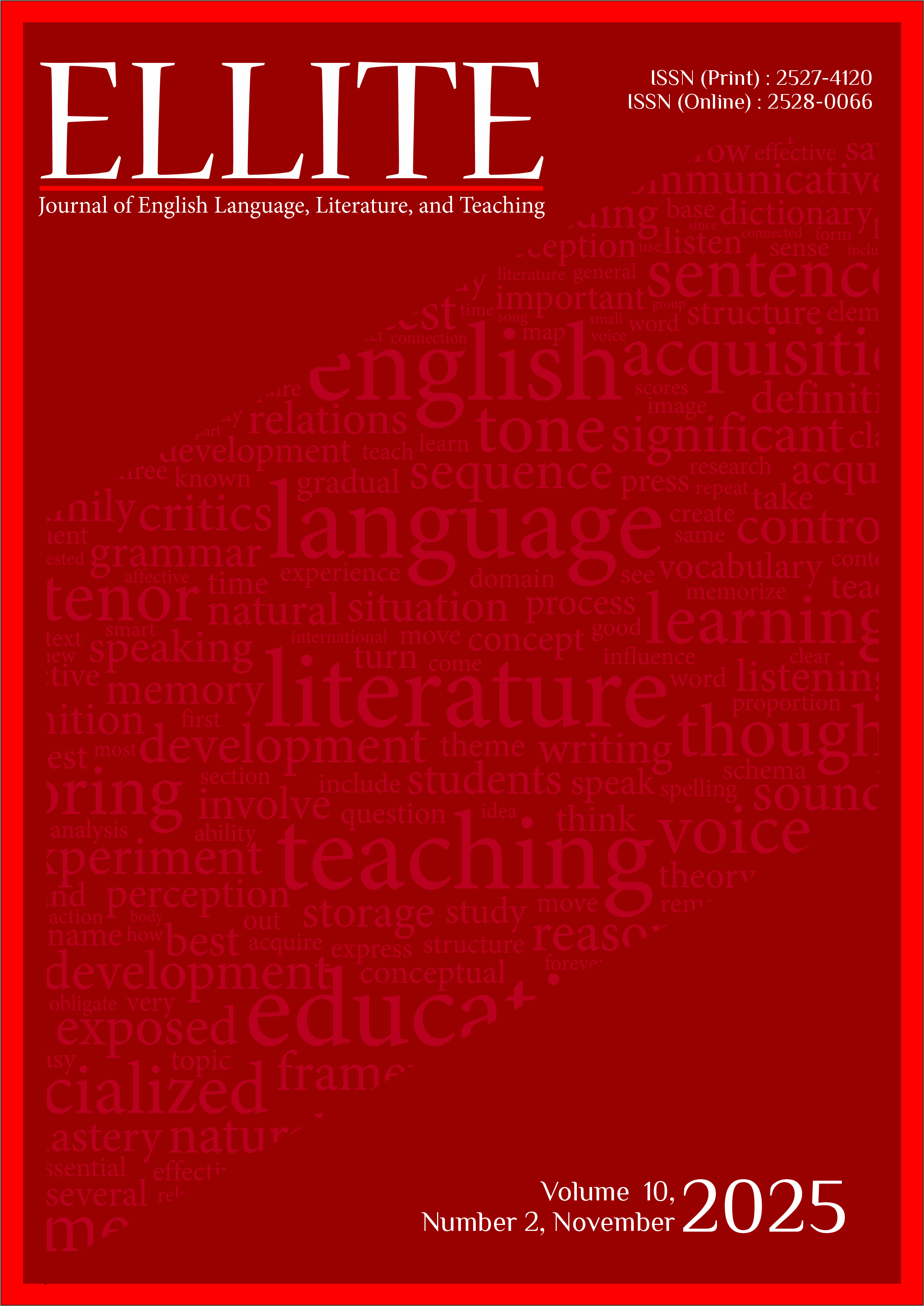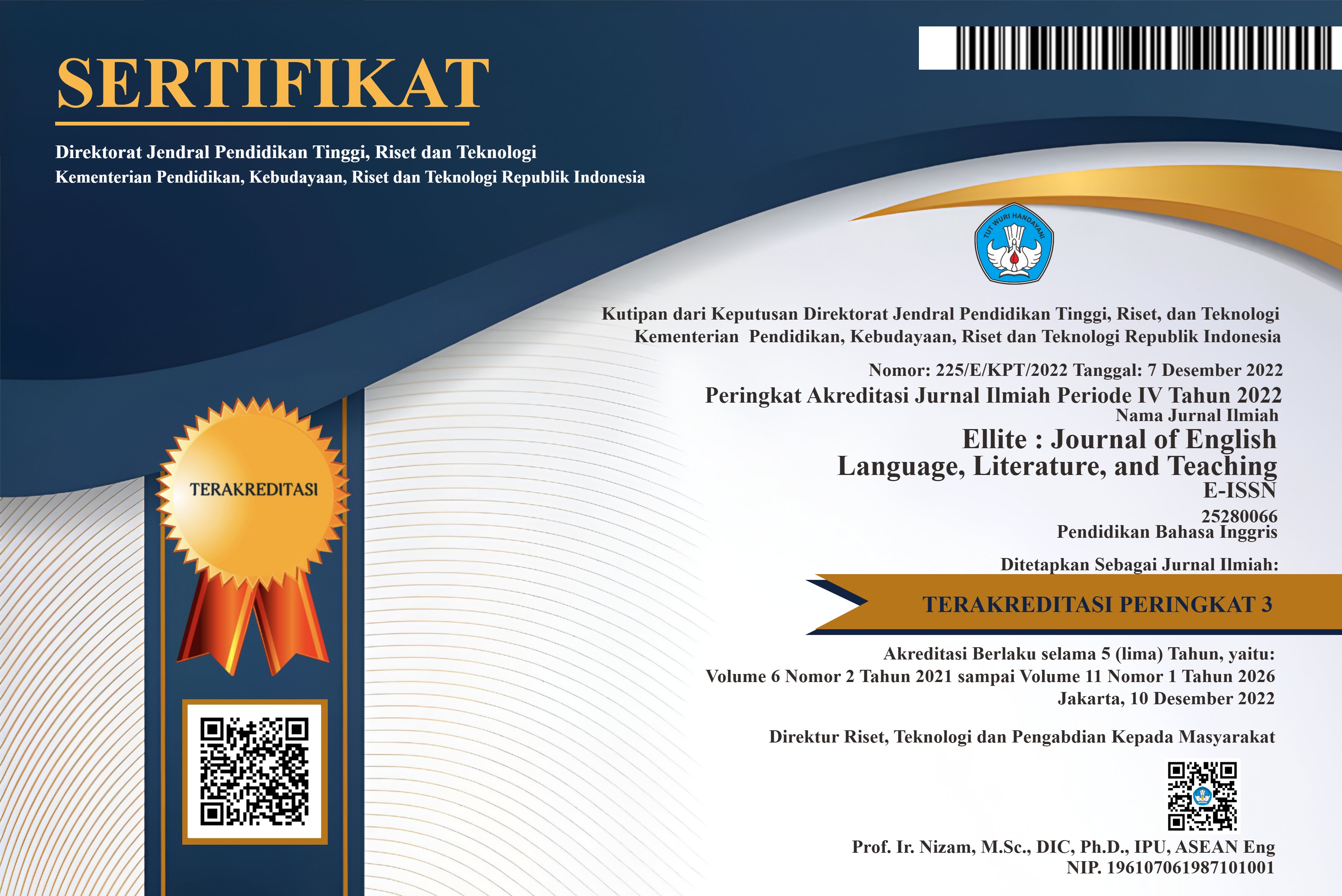Integrating Animated Videos, Songs, and Games to Enhance Young Learners’ Vocabulary Learning in EFL Classrooms: A Descriptive Study in Thai Elementary School
DOI:
https://doi.org/10.32528/ellite.v10i2.3692Keywords:
audiovisual media; EFL classroom; young learners; English vocabulary learningAbstract
This study aimed to explore how animated educational videos, song clips, and audiovisual game-based learning support vocabulary acquisition, interaction, and active participation among fourth-grade students in an EFL classroom. Using a descriptive qualitative design, the research was conducted in a Thai elementary school with 22 students aged 9-10. Data were collected over seven English lessons through structured non-participant observations and detailed field notes, focusing on behavioral indicators of engagement, understanding, and peer collaboration. Research findings revealed that animated videos helped clarify abstract vocabulary through visual storytelling and repetition, while song clips promoted memorability and emotional involvement through rhythm and movement. Audiovisual games, on the other hand, encouraged sustained focus, classroom interaction, and vocabulary application through playful, feedback-rich activities. Each tool contributed uniquely to different stages of learning, highlighting the value of varied, multimodal media use. This study offers practical insights into how thoughtfully integrated audiovisual tools can enrich English instruction for young learners. It encourages educators to strategically align media types with lesson goals and learner characteristics, particularly in environments with limited access to authentic English use.
References
REFERENCES
Astutik, Y., Agustina, S., Megawati, F., & Anggraini, R. (2023). Increasing English teachers’ innovation through training on teaching modules development with digital technology integration. Journal of Community Service and Empowerment, 4(3), 459–466. https://doi.org/10.22219/jcse.v4i3.27579
Astutik, Y., & Aulina, C. N. (2017). Metode total physical response (TPR) pada pengajaran bahasa Inggris Siswa Taman Kanak-Kanak. Metode Total Physical Response (TPR) Pada Pengajaran Bahasa Inggris Siswa Taman Kanak-Kanak, 17(2), 9–23.
Astutik, Y., Setiawan, S., Anam, S., & Suhartono. (2022). “I Can Teach With My Videos”: How Do Teachers Teach English to Young Learners in a Technology-Limited Environment? International Journal of Learning, Teaching and Educational Research, 21(7), 158–177. https://doi.org/10.26803/ijlter.21.7.9
Brown, H. D., & Lee, H. (2015). Teaching by principles: An interactive approach to language pedagogy. Pearson.
Budianto, S., Sayidah, N., Sucipto, S., & Mustofa, A. (2022). Young Learners Preferences on Using Games and Songs for Learning English in EFL Context. Education Quarterly Reviews, 5(4), 90–95. https://doi.org/10.31014/aior.1993.05.04.574
Coşkun, A. (2023). Perception of Boredom in Young Learners’ English Language Classes. Educatione, 2(2), 196–217. https://doi.org/10.58650/educatione.1331880
Coşkun, A., & Yüksel, Y. (2021). Examining English as a Foreign Language Students’ Boredom in terms of Different Variables. Acuity: Journal of English Language Pedagogy, Literature and Culture, 7(1), 19–36. https://doi.org/10.35974/acuity.v7i2.2539
Creswell, J. W., & Poth, C. N. (2016). Qualitative inquiry and research design: Choosing among five approaches. Sage publications.
Dalimunthe, L., & Yogo Purnomo, S. (2022). the Effect of Using Audio Visual Media on Students’ English Speaking Ability. 1(2), 38–42. http://lingua.educationis
Feng, Q., & Guo, Z. (2025). A Case Study: Investigating High School English Student Engagement in Language Learning through YouTube Music Videos. Forum for Linguistic Studies, 7(1), 260–271. https://doi.org/10.30564/fls.v7i1.7631
Garcia-Marchena, O. (2020). David Crystal, The Cambridge Encyclopedia of the English Language . Cambridge University Press, 2019, 506 pages. Lexis. Journal in English Lexicology.
Irmawati, I., Ihsan, M., & Rasmi, R. (2020). Utilizing Audio Visual Aids To Improve English Speaking Skill for the Eight Grade Students of Smp Negeri 3 Banawa. Datokarama English Education Journal, 1(1), 61–72. https://doi.org/10.24239/dee.v1i1.6
Kartika, dewi, Siahaan, S., Herman, H., Rumapea, E. L., Fermiska Silalahi, T., Hkbp, U., Pematangsiantar, N., Tinggi, S., Ekonomi, I., & Bitung, P. (2023). Implementation of Audio-Visual Teaching Media in Improving Students’ Listening Comprehension: A Case on Teaching Method. Print) Journal of English Langaugeand Education, 8(2), 2023.
Kholidya, C. F., & Rofiah, K. (2019). Mr. Mustache and Friends: A Song Animation Video Development Based on Signalong Indonesia. Social Sciences, Humanities and Education Conference (SoSHEC 2019), 102–105.
Kleftodimos, A. (2024). Computer-Animated Videos in Education: A Comprehensive Review and Teacher Experiences from Animation Creation. Digital, 4(3), 613–647. https://doi.org/10.3390/digital4030031
Laksmi, N. K. ., Yasa, I. K. ., & Mirayani, K. A. M. (2021). The use of animation video as learning media for young. Universitas Pendidikan Ganesha, 42–52.
Mayer, R. E. (2020). Multimedia Learning (3rd ed.). Cambridge University Press. https://doi.org/DOI: 10.1017/9781316941355
Mousavian Rad, S. E., Roohani, A., & Mirzaei, A. (2022). Developing and validating precursors of students’ boredom in EFL classes: An exploratory sequential mixed-methods study. Journal of Multilingual and Multicultural Development, 1–18.
Pfenninger, S. E., & Singleton, D. (2017). Beyond age effects in instructional L2 learning: Revisiting the age factor (Vol. 113). Multilingual Matters.
Rahmati, J., Izadpanah, S., & Shahnavaz, A. (2021). A meta-analysis on educational technology in English language teaching. Language Testing in Asia, 11(1). https://doi.org/10.1186/s40468-021-00121-w
Regina, D., & Christopher Rajasekaran, W. (2023). A Study on Understanding the Effectiveness of Audiovisual Aids in Improving English Vocabulary in ESL Classrooms. World Journal of English Language, 13(8), 446–452. https://doi.org/10.5430/wjel.v13n8p446
Ricardo, R., & Meilani, R. I. (2017). TRicardo, R., & Meilani, R. I. (2017). The impacts of students’ learning interest and motivation on their learning outcomes. Jurnal Pendidikan Manajemen Perkantoran, 1(1), 79–92.he impacts of students’ learning interest and motivation on their learning ou. Jurnal Pendidikan Manajemen Perkantoran, 1(1), 79–92.
Sanjaya, I. E. (2023). The Benefits and Challenge of Implementing Audiovisual Material to Improve Students’ English Skills for Junior High SCHOOL STUDENTS. Universitas Kristen Duta Wacana.
Satria, F., Aditra, H., Wibowo, M. D. A., Luthfiansyah, H., Suryani, M., Paulus, E., & Suryana, I. (2017). EFL learning media for early childhood through speech recognition application. Proceeding - 2017 3rd International Conference on Science in Information Technology: Theory and Application of IT for Education, Industry and Society in Big Data Era, ICSITech 2017, 2018-Janua, 568–572. https://doi.org/10.1109/ICSITech.2017.8257177
Teo, T., & Zhou, M. (2017). TTeo, T., & Zhou, M. (2017). The influence of teachers’ conceptions of teaching and learning on their technology acceptance. Interactive Learning Environments, 25(4), 513–527.he influence of teachers’ conceptions of teaching and learning on their technolo. Interactive Learning Environments, 25(4), 513–527.
Vnucko, G., Kralova, Z., & Tirpakova, A. (2024). Exploring the relationship between digital gaming, language attitudes, and academic success in EFL university students. Heliyon, 10(13), e33301. https://doi.org/10.1016/j.heliyon.2024.e33301
Yulian, R., Ruhama’, U., & Utami, P. Y. (2022). EFL Slow Learners’ Perception in Speaking with Authentic Multimedia Assisted Language Learning. International Journal of Language Education, 6(2), 183–195. https://doi.org/10.26858/ijole.v6i2.21511
Downloads
Published
Issue
Section
Categories
License
Copyright (c) 2025 Yuli Astutik, Raditya Ferdi Riyanto, Sheila Agustina, Nantana Mongboon, Imam Pribadi

This work is licensed under a Creative Commons Attribution 4.0 International License.







